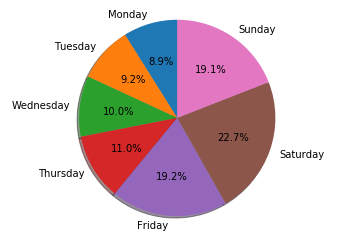This is a data analytics project on road traffic accidents to draw inferences and use these insights in minimizing the rate of accidents. There were 3 datasets considered from different regions, primarily Australia, India and the UK (Link : https://www.kaggle.com/silicon99/dft-accident-data/ ). A few of them have been uploaded. Some of the inferences drawn from the dataset have been added below
The pie chart shows us that over 61% of the accidents happen over the weekend (Friday-Sunday). This is a major concern and stricter measures of security, increase in police personnel could be two solutions that enforcement agencies can look into in areas of pubs, bars and restaurants over the weekend, so as to attempt in minimizing the rate of accidents
An Indian dataset was considered to analyze the types of vehicles involved in accidents. The highest percentage, which is around 35% is to 2-wheelers. The percentage of heavy vehicles which include trucks, heavy duty lorries, tractors, etc. is also reasonably high. This implies that different vehicles can be dealt with differently. This could mean multiple lanes for different types of vehicles to deal with accidents better.
The chart tells us that it is the driver’s fault over 80% of the times. Contrary to popular belief, the fault does fall on the driver in most cases. It is also important to note other factors like stray animals, light, road and weather conditions, etc. also play a part in these accidents taking place.
This is a metric which is defined as total deaths per 100 accidents. The number of vehicles have always been increasing every year, and this could also be a cause in the trend observed in Fig.7.5.4. A small rise can be seen in the years 2012 and 2014. But, a great rise is seen from 2014 to 2016. This implies, an increase in the fatalities per 100 accidents in the 2 years.



